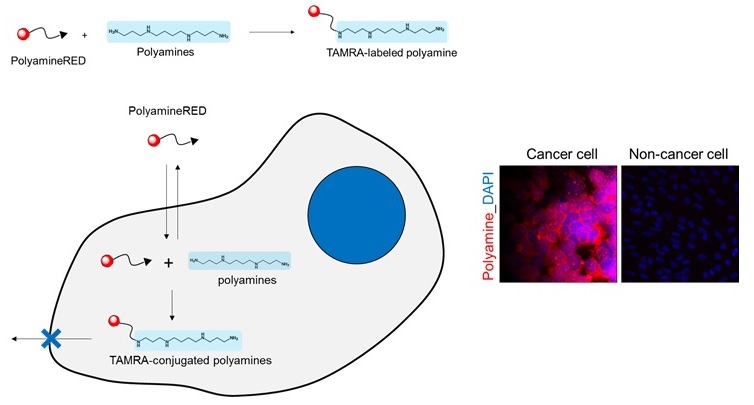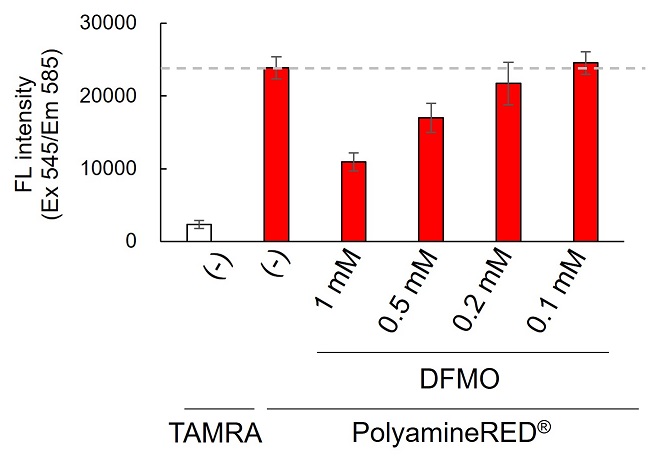Intracellular Polyamine Imaging Reagent PolyamineRED™ | Funakoshi
Date:June 28 2018Web Page No:81084

Funakoshi Co.,Ltd.

PolyamineRED™ is a reagent for imaging intracellular polyamines specifically without any pretreatment or cell lysis. This can be used for live cells, therefore it is suitable for detection or semi-quantitative analysis of intracellular polyamines.
* This product has been commercialized with the support of Biofunctional Synthetic Chemistry Laboratory, RIKEN.
- What is Polyamine
- Principle
- Features
- Application
- How to Use
- Application Data
- Original Paper
- Video
- Product Information
What is Polyamine
Principle

PolyamineRED™ is a compound containing red fluorescent dye TAMRA and glycine propagylester. It is a reagent that specifically labels TAMRA using the phenomenon that glycine propagylester specifically reacts with the terminal primary amine of polyamine.
PolyamineRED™ has excellent cell membrane permeability and is reversibly incorporated into cells when added to cells. Once incorporated into cells, PolyamineRED™ reacts with polyamines and labels TAMRA with polyamines in cells. While unreacted-PolyamineRED™ can be removed by washing because of its cell-penetrating propertes, TAMRA-bound-polyamine loses cell-penetrating property and remains in cells. Therefore, by washing the cells after staining, relative quantification and imaging of intracellular polyamines are possible.
※ Note: PolyamineRED™ shows red fluorescence regardless of reaction with polyamines. Therefore, cell washing is necessary for polyamine specific detection. TAMRA can be used as a negative control in a fluorescent plate reader or other quantitative laboratory system to evaluate the adequacy of washing.
Reference: Selectivity of glycine propagyl ester to polyamines
A model molecule of glycine propagyl ester (benzyloxycarbonyl glycine propagyl ester) was reacted with polyamines (spermine, spermidine and putrescine), amino acids and monoamines, then the reactants were followed by HPLC.
The reaction proceeded only with polyamines (spermine, spermidine, putrescine) and hardly with monoamines (epinephrine) and amino acids (lysine). Reactivity to polyamines tended to increase with the number of amino groups. (citated by original paper)
| Substance | Spermine | Spermidine | Putrescine | Epinephrine | Lysine |
|---|---|---|---|---|---|
| Reaction Rate% | 82% | 78% | 66% | <1% | 2% |
Features
- PolyamineRED™ is a reagent that utilizes the specific and rapid reaction of glycine propagyl ester with polyamines. By labeling polyamines with TAMRA, intracellular polyamines can be visualized.
- It can be observed with a filter set of rhodamine (Ex/Em: 560 nm/585 nm).
- It shows high specificity for polyamines (putrescine, spermidine, and spermine) and hardly reacts with amino acids or monoamines.
- It is permeable to cell membranes and can be used to detect polyamines in living cells. Unreacted reagents can be removed by washing, and polyamine-TAMRA adducts remain in cells due to the polycationic nature of polyamines.
- Intracellular polyamines can be detected by simple operation without any pretreatment.
- The amount of total polyamines can be semi-quantitated by intracellular fluorescence intensity*.
- The intracellular localization of polyamines can be observed.
* In order to detect total polyamines, it is not possible to quantify individual polyamines.
Reference data: Absorption and fluorescence spectrum of PolyamineRED™
Absorption (dotted line) and emission (solid line) spectra of PolyamineRED™ alone (Black) and PolyamineRED™+spermine (Red) in PBS. No change in fluorescence spectra was observed in the presence or absence of polyamines.

Application
- Semiquantitative determination of intracellular polyamines
- Localization of intracellular polyamines
How to Use
- Add PolyamineRED™ to fresh medium at a final concentration of 10-30 μM.
- Remove culture medium from cultured cells and wash with PBS 2 times.
- Add PolyamineRED™-containing medium.
- Incubate cells for at least 10 min.
- Wash cells 3 times with PBS.
- After formaldehyde fixation, perform optional staining and observe.
※ Methanol fixation is not recommended because polyamine components may leak out of the cells.
Application Data
Polyamine detection in cancer cells and normal cells
Three cancer cell lines (MCF7, MDA-MB-231, SK-BR-3) and two normal cells (MCF10A, lymphocyte) were treated with 30 μM of PolyamineRED™ for 10 min, washed three times with PBS, followed by DAPI staining and formalin fixation. TAMRA fluorescence was detected in cancer cell lines significantly. On the other hand, because of the low polyamine levels in normal cells, little TAMRA signal was detected in MCF10A and lymphocytes.
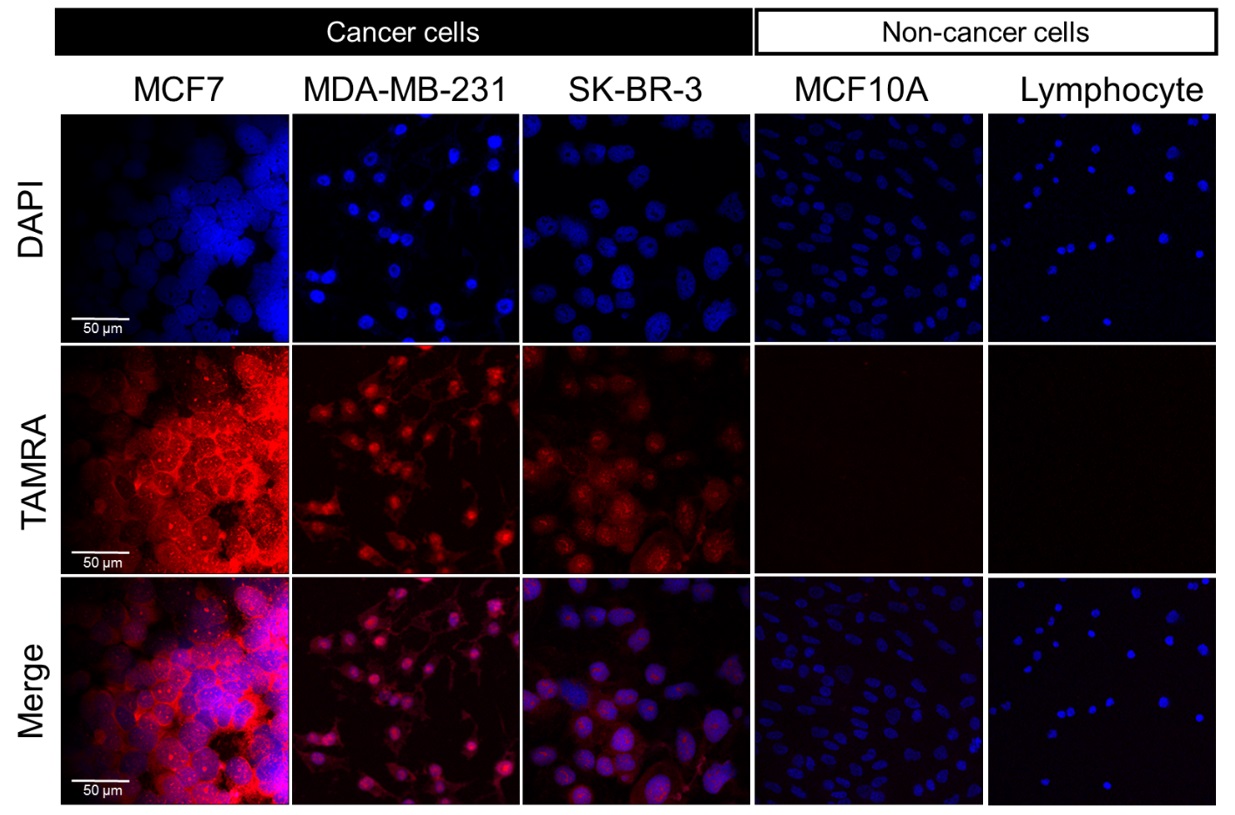
Intracellular localization of polyamines
MDA-MB-231 cells were treated with 30 μM of PolyamineRED™ for 10 min, stained by DAPI and fixed. Major TAMRA signal was detected in nucleus. This indicates polyamines in MDA-MB-231 are mainly localized in nucleus.
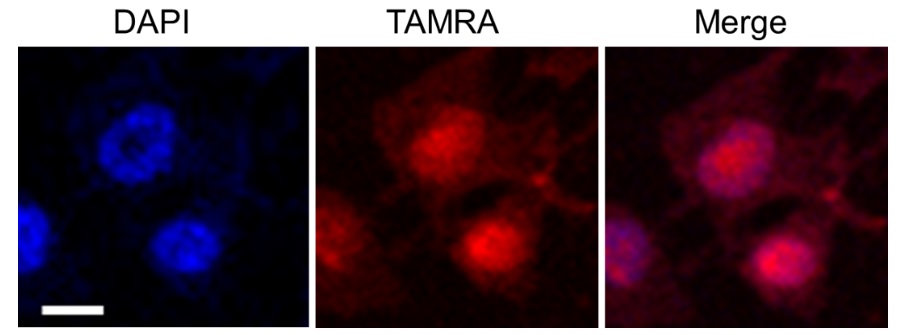
Detection of PolyamineRED™ signal from cell lysate
786-O cells were seeded in 24 well plates, cultured for 1 day, and treated with DFMO (1 mM), an ornithine synthase inhibitor, in serum-free DMEM medium under confluent conditions for 16 hours. A final concentration of 20 μM PolyamineRED™ or TAMRA (negative control) was added to the cells and allowed to react for 4 hours. After washing the cells 3 times with PBS, PBS containing 1% SDS was added to prepare cell lysates. The fluorescence intensity (Ex 540±10 nm/Em 585±20 nm) of each cell lysate was measured with a fluorescence spectrophotometer. The fluorescence intensity of the cell lysate treated with PolyamineRED™ was remarkably superior to that of the cell lysate treated with TAMRA (negative control), and sufficient specific signals were detected in the cell lysate. In addition, DFMO significantly attenuated the signal, indicating that the biosynthesis of polyamines was suppressed.
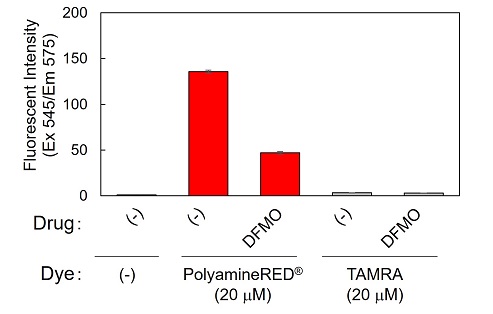
High-throughput cell-based detection by fluorescent plate leader
786-O cells were seeded in 96 well plates and cultured for 1 day. Under confluent conditions, various drugs were added to phenol red-free DMEM medium and treated for 16 hours. A final concentration of 10 μM PolyamineRED™ or TAMRA (negative control) was added to the medium and allowed to react for 4 hours. The cells were washed with PBS 3 times, fresh PBS was added, and the fluorescence intensity (Ex 545±5 nm/Em 585±10 nm) was measured with a fluorescent plate reader (transmission type measurement). The fluorescence intensity of cells treated with PolyamineRED™ was significantly superior to that of TAMRA dye, which was used as a negative control, and sufficient specific signals were detected with a fluorescent plate reader.
Original Paper
- K. Vong, K. Tsubokura, Y. Nakao, T. Tanei, S. Noguchi, S. Kitazume, N. Taniguchi, K. Tanaka, "Cancer cell targeting driven by selective polyamine reactivity with glycine propargyl esters.", Chem. Commun., 53, 8403~8406 (2017). [PMID : 28589196]
Video
Product Information
[Date : January 05 2026 00:07]
| Detail | Product Name | Product Code | Supplier | Size | Price | ||||||||||||||||||||||||||||||
|---|---|---|---|---|---|---|---|---|---|---|---|---|---|---|---|---|---|---|---|---|---|---|---|---|---|---|---|---|---|---|---|---|---|---|---|
|
PolyamineRED, Intracellular Polyamine Detection Reagent DatasheetThis may not be the latest data sheet. |
FDV-0020 | FNAFunakoshi Co.,Ltd. | 0.5 mg | $380 | |||||||||||||||||||||||||||||||
|
|
|
||||||||||||||||||||||||||||||||||
[Date : January 05 2026 00:07]
PolyamineRED, Intracellular Polyamine Detection Reagent
DatasheetThis may not be the latest data sheet.
- Product Code: FDV-0020
- Supplier: FNA
- Size: 0.5mg
- Price: $380
| Description |
A reagent for imaging intracellular polyamines specifically without any pretreatment or cell lysis. This can be used for live cells. |
||
|---|---|---|---|
| Storage | -20°C | CAS | |
| Link |
|
||
You may also like
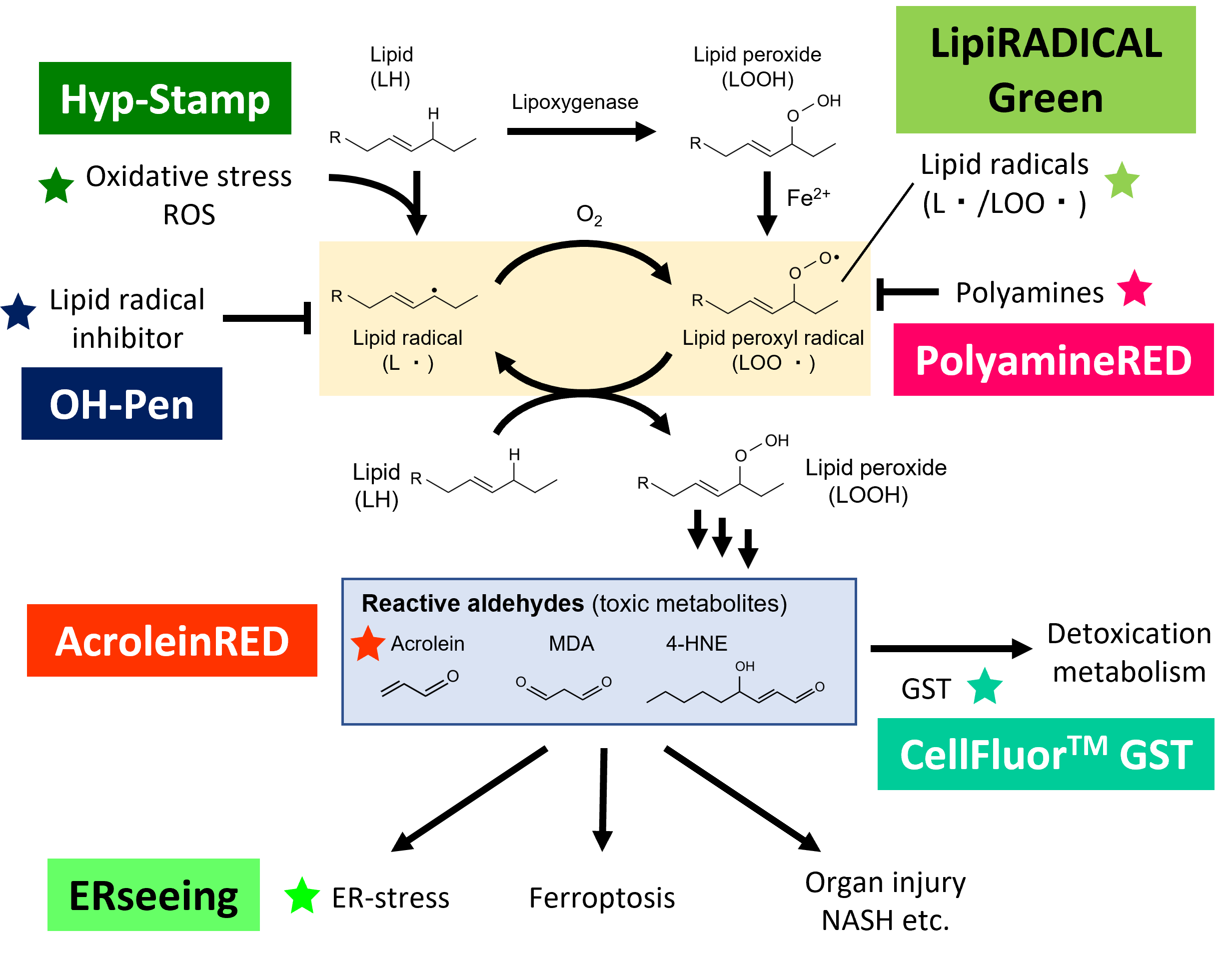
CONTACT
export@funakoshi.co.jp
- ※Prices on our website are for your reference only. Please inquire your distributor for your prices.
- ※Please note that Product Information or Price may change without notice.
